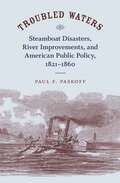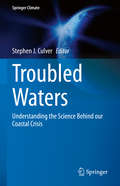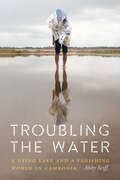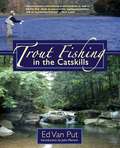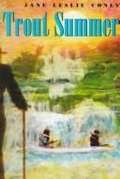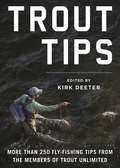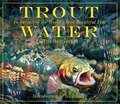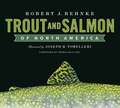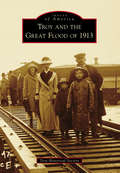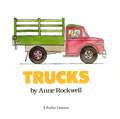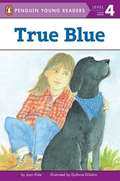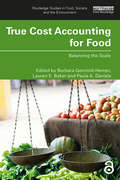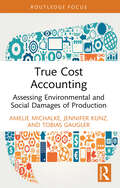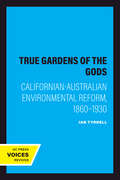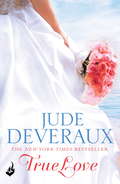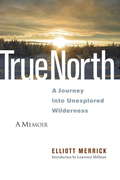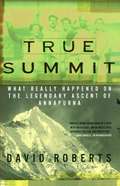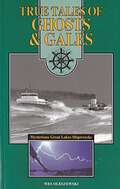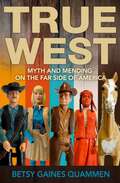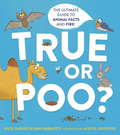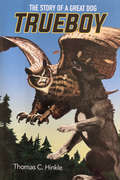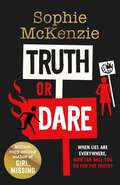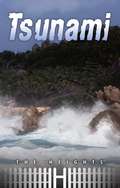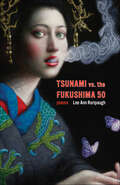- Table View
- List View
Troubled Waters: Steamboat Disasters, River Improvements, and American Public Policy, 1821--1860
by Paul F. PaskoffIn Troubled Waters, Paul F. Paskoff offers a comprehensive examination of the federal government's river improvements program, which aimed to reduce hazards to navigation on the great rivers of America's interior during the early and mid-nineteenth century. Danger on the rivers came in a variety of forms. Shoals, rapids, ice, rocks, sandbars, and uprooted trees and submerged steamboat wrecks lodged in river beds were the most common perils and accounted for the largest number of steamboat disasters. This daunting array of river hazards required a similarly broad range of efforts to remove or at least ameliorate them. Against a variety of obstacles -- natural, political, and technological -- the river improvements program succeeded in reducing the rate of steamboat loss, even as steamboat traffic dramatically increased. Its success, Paskoff argues, demonstrates that the federal government was far more active than generally thought in promoting economic growth and development in the years leading up to the Civil War.The river improvements program was one of the most volatile issues in national, sectional, and state politics, touching on questions of economic development, constitutional law, partisan politics, and sectional rivalry. Paskoff examines the controversial program from its beginnings during the early republic to 1844, giving careful attention to the policies of Andrew Jackson's administration. He explores the array of objections to the program -- some grounded in a strict interpretation of the Constitution and others in a concern over alleged federal wantonness, corruption, and waste -- and follows the political story through the administration of James K. Polk forward to secession. Paskoff also explains the fiscal, economic, and technological aspects of the hazard problem and its solution, analyzing the federal government's fiscal condition, its capacity to undertake such an ambitious program, and the influence of conditions in the larger economy, including effects of the Mexican War, upon the federal government's finances.Paskoff's lively analysis rests on a bedrock of impressive quantitative evidence, including databases containing every documented steamboat wreck -- more than 1,200 -- on American rivers, lakes, and coastal waters; construction and engine data for more than 600 steamboat packets; and all relevant federal appropriations and expenditures measures, more than 2,300 spending projects in all. Vigorously researched and vividly told, Troubled Waters is an essential contribution to the history of internal improvements in the antebellum United States.
Troubled Waters: Understanding the Science Behind our Coastal Crisis (Springer Climate)
by Stephen J. CulverThe book communicates coastal geology such that the reader gets a better understanding of how scientists work and how scientific knowledge is acquired and how it progresses. It presents the human side of geologic research, including missteps, in this case, research on coastal change of the recent past, the present, and the near future. The audience for this volume is the general public, coastal managers, politicians, and decision makers in general, in the coastal realm. But the implications of this work with regard to future climate change and human responses are relevant globally.
Troubling the Water: A Dying Lake and a Vanishing World in Cambodia
by Abby SeiffIn this intimate account of one of the world&’s most productive inland fisheries, Troubling the Water explores how the rapid destruction of a single lake in Cambodia is upending the lives of millions. The abundance of Cambodia&’s Tonle Sap Lake helped grow the country for millenia and gave rise to the Kingdom of Angkor. Fed by the rich, mud-colored waters of the powerful Mekong River, the lake owes its vast bounty to an ecological miracle that has captivated poets, artisans, and explorers throughout history. But today, the lake is dying. Hydropower dams hold back billions of gallons of water and disrupt critical fish migration paths. On the lake, illegal fishing abetted by corruption is now unstoppable. A fast-changing climate, meanwhile, has seen a string of devastating droughts.Troubling the Water follows ordinary Cambodians coping with the rapid erasure of a long-held way of life. Drawing on years of reporting in Cambodia, Abby Seiff traces the changes on the Tonle Sap—weaving together vivid stories of those most affected with sharp insight into one of the most threatened lakes in the world. For the millions who depend on it, the stakes couldn&’t be higher.
Trout Fishing in the Catskills
by Ed Van Put John MerwinEd Van Put begins this important book with the history of native brook trout and offers little-known details about their sizes, range, and demise from over-fishing, the growth of streamside industries, and the introduction of competitive species. Sweeping in its scope, Trout Fishing in the Catskills tells a thorough tale of the often tumultuous history of fishing in the Catskills. With a scope of over a century, Van Put tells of the Catskill's frontier fishing beginnings and tracks the rise, fall, and eventual revival of the fisheries. Throughout, this is a history of people and methods as well as rivers, and there are profiles of Theodore Gordon, Art Flick, Harry and Elsie Darbee, Sparse Grey Hackle, and more. No serious trout fisherman, in any part of the country, will want to miss this pioneering portrait of a seminal region in American angling history.
Trout Summer
by Jane Leslie ConlyShana and Cody are outdoor kids; they don't belong in Laglade, Maryland. But that's the suburb Mama uprooted them to, after Daddy left home. There's only one good thing about Laglade: Mama has found them a cabin near a river in the woods where they can go on the weekends. Soon Shana convinces Mama that she and Cody can stay in the cabin on their own if they promise to be good and stay out of trouble. But trouble takes the unexpected shape of a cat, a gun, a few lies, and a cantankerous old forest ranger who doesn't like Cody and Shana messing around with his river--until the day he's ready to go over the falls for the last time. Jane Leslie Conly tells a riveting story about trust and change, hidden strengths and hidden treasures, in this gripping middle-grade novel.
Trout Tips: More than 250 fly-fishing tips from the members of Trout Unlimited
by Kirk DeeterFrom the mighty rivers of the Pacific Northwest, to the rolling streams of New England, to the freestone streams of the Appalachians, to the frigid waters of Canada, fly fishing is a sport embraced by anglers from all corners of North America. And now from the members of the highly respected conservation organization Trout Unlimited comes a comprehensive volume of tested tips and tactics for flyfishermen from every region and of every skill level.The Trout Unlimited Book of Fly-Fishing Tips covers every aspect of fly fishing. Learn how to select the rod, reel, and fly line that are best suited for your type of fishing. Perfect your casting techniques so you can place your dry fly, nymph, wet fly, or streamer exactly where you want it to be, then get a proper drift over likely holding areas. Want to learn how to tie your own flies? It’s easy with the tips from TU’s tiers. Want to know how to read water, no matter what the conditions? Look no further than this book. Here you’ll find chapters featuring these tips, plus advice on wading, fighting fish, and tying bombproof knots, and much more in this compact and insightful book.Whether you’re a beginning angler looking to get into the sport or an experienced flyfisherman wanting to hone your skills, The Trout Unlimited Book of Fly-Fishing Tips is sure to provide you with tips, tactics, and techniques that will make you a better angler.Skyhorse Publishing is proud to publish a broad range of books for fishermen. Our books for anglers include titles that focus on fly fishing, bait fishing, fly-casting, spin casting, deep sea fishing, and surf fishing. Our books offer both practical advice on tackle, techniques, knots, and more, as well as lyrical prose on fishing for bass, trout, salmon, crappie, baitfish, catfish, and more. While not every title we publish becomes a New York Times bestseller or a national bestseller, we are committed to publishing books on subjects that are sometimes overlooked by other publishers and to authors whose work might not otherwise find a home.
Trout Water: In Pursuit of the World's Most Beautiful Fish
by Nick Lyons Jim RowinskiThrough extraordinary photographs and prose, Trout Water brings to life the waters where trout make their home, creating an intimate portrait of the nature of the living river and the fly fisherman’s passion for these wild places. Every river’s story is unique, but each shares a fundamental set of characteristics. Trout Water illustrates the compelling mystery and complexity of these rivers and the diverse trout species that call them home. Brought to life through Jim Rowinski’s artistic vision, Trout Water reveals the magical world of running water, elusive trout, and the bond between man and river. The book follows the geological and historical nature of trout waters, the fundamental features and characteristics that make up trout water, and the beautiful places where fishermen pursue wild trout. With an illuminating foreword by legendary fly fisherman and author Nick Lyons, this is a book that no trout fisherman should be without.
Trout and Salmon of North America
by Thomas Mcguane Joe Tomelleri Robert BehnkeThis beautiful and definitive guide brings together the world's lead leading expert on North American trout and salmon, Robert Behnke, and the foremost illustrator in the field, Joseph Tomelleri. North America is graced with the greatest diversity of trout and salmon on earth. From tiny brook trout in mountain streams of the Northeast, to cutthroat trout in the rivers of the Rockies, to Chinook salmon of the Pacific, the continent is home to more than 70 types of trout and salmon. How this came to be, how they are related, and what makes them unique -- and so breathtaking -- is the story of Trout and Salmon of North America. The more than 100 illustrations of trout and salmon by Joseph Tomelleri showcased here exhibit a genius for detail, coloration, and proportion. Each portrait is made from field notes, streamside observations, photographs, and specimens collected by the artist. The result is a set of the most accurate and stunning illustrations of fish ever created. Robert Behnke has distilled 50 years of his research and writing about trout and salmon in completing this book. No one understands better than Behnke the diversity and conservation issues concerning these fishes or communicates so lucidly the biological wonders and complexities of their particular beauty. Also included are more than 40 richly detailed maps that clearly show the ranges of populations of trout and salmon throughout North America. An irresistible delight for anyone who appreciates natural history, Trout and Salmon of North America is a master guide to the natural elegance of our native fishes.
Troy and the Great Flood of 1913
by Troy Historical SocietyThe rain began to fall on Easter Sunday, March 23, 1913. In Troy, 15 people lost their lives during the flood due to drowning, and in the weeks and months that followed an unknown number died from flood-related diseases. The story of what happened in Troy has often been overlooked, but in 1976 the Troy Historical Society Oral History Committee interviewed Troy flood survivors as a project for the bicentennial of the United States. These interviews, preserved on audiotapes, provide researchers firsthand accounts of what happened in the town. The late Mrs. Lois Shilling Davies, a past president of the Troy Historical Society who lived in Troy during the flood, deserves much of the credit for this invaluable resource, for it is she who conducted many of the interviews. Images of America: Troy and the Great Flood of 1913 relates how residents endured without having any instruction or experience in emergency preparedness. This is a celebration of human bravery, kindness, and ingenuity--of people who triumphed over tragedy.
True Blue
by Joan ElsteBlue has a very sharp nose. He can smell trouble from a mile away. But now Blue has disappeared and might be in trouble himself! Blue will have to be very brave if he wants to make it home to his owner, J. D.
True Blue: The Oxford Boat Race Mutiny
by Patrick Robinson Daniel TopolskiFrom the book: In the harsh winter of 1986/7, an event took place in the Oxford University Boat Club which shook the University, and the rowing establishment, to their foundations. It became known, simply, as the Oxford Mutiny. A group of American students, all former internationals, had arrived at Oxford hoping to put some steel into a Boat Race crew still reeling from their recent humiliating defeat at the hands of Cambridge - a hammering which had ended an astounding ten-year winning streak by Oxford. But disagreements over training methods soon brought into focus a bitter clash of personalities between a quiet Scottish mature student, Donald Macdonald, the elected president of the Dark Blues, and a fierytempered rower from California, Christopher Clark. Embodying the amateur sporting traditions of the Boat Race on the one hand, and New World big-star sportsmanship on the other, these two men found two warring factions lining up behind them. The ensuing battle for the control of the Oxford University Boat Club raged for months, making headline news all over the world. Daniel Topolski who, as Chief Coach, had been the architect of Oxford's success, and who now found himself in the middle of this unprecedented row, has finally told his side of the story. Having lost their bid to oust Macdonald, the rebels pulled out of the Boat Race squad just six weeks before the race. Could he, against all odds, mould the inexperienced and demoralised reserve crew of no-hopers into a winning team? Reminiscent of Chariots of Fire, this book is not just about rowing, or even about sport. It concerns the clash of traditional and modern values; petty hatreds and great friendships; and, above all, the triumph of the human spirit.
True Cost Accounting for Food: Balancing the Scale (Routledge Studies in Food, Society and the Environment)
by Barbara Gemmill-HerrenThis book explains how True Cost Accounting is an effective tool we can use to address the pervasive imbalance in our food system. Calls are coming from all quarters that the food system is broken and needs a radical transformation. A system that feeds many yet continues to create both extreme hunger and diet-related diseases, and one which has significant environmental impacts, is not serving the world adequately. This volume argues that True Cost Accounting in our food system can create a framework for a systemic shift. What sounds on the surface like a practice relegated to accountants is ultimately a call for a new lens on the valuation of food and a new relationship with the food we eat, starting with the reform of a system out of balance. From the true cost of corn, rice and water, to incentives for soil health, the chapters economically compare conventional and regenerative, more equitable farming practices in and food system structures, including taking an unflinching look at the true cost of cheap labour. Overall, this volume points towards the potential for our food system to be more human-centred than profit-centred and one that has a more respectful relationship to the planet. It sets forth a path forward based on True Cost Accounting for food. This path seeks to fix our current food metrics, in policy and in practice, by applying a holistic lens that evaluates the actual costs and benefits of different food systems, and the impacts and dependencies between natural systems, human systems, agriculture and food systems. This volume is essential reading for professionals and policymakers involved in developing and reforming the food system, as well as students and scholars working on food policy, food systems and sustainability.
True Cost Accounting: Assessing Environmental and Social Damages of Production (Routledge Focus on Environment and Sustainability)
by Jennifer Kunz Amelie Michalke Tobias GauglerThis book explores the historical and theoretical classification of True Cost Accounting (TCA) and its business-oriented ways of implementation.Tobias Gaugler, Jennifer Kunz, and Amelie Michalke provide compact and comprehensible insights into TCA, which is one approach used to comprehensively assess actual (human or natural) resource consumption and implement this assessment into companies’ internal controlling. To achieve this goal, the volume locates this approach in existing economic theory and shows its historical roots and progressions. The authors then present different methodological approaches within TCA and highlight how practitioners might implement these approaches in their business. To illustrate the importance of TCA, a number of practical examples that are already present in the market are also featured.This volume will be of great interest to students and scholars of environmental economics. Further, practitioners in (sustainable) supply chain management, as well as ecological and social accounting and controlling, can use it for inspiration and guidance. Additionally, this book and the inherent ideas will give policymakers in economic and social politics recommendations for action.
True Gardens of the Gods: Californian-Australian Environmental Reform, 1860–1930
by Ian TyrrellOne of the most critical environmental challenges facing both Californians and Australians in the 1860s involved the aftermath of the gold rushes. Settlers on both continents faced the disruptive impacts of mining, grazing, and agriculture; in response to these challenges, environmental reformers attempted to remake the natural environment into an idealized garden landscape. As this cutting-edge history shows, an important result of this nineteenth-century effort to "renovate" nature was a far-reaching exchange of ideas between the United States—especially in California—and Australia. Ian Tyrrell demonstrates how Californians and Australians shared plants, insects, personnel, technology, and dreams, creating a system of environmental exchange that transcended national and natural boundaries. True Gardens of the Gods traces a new nineteenth-century environmental sensibility that emerged from the collision of European expansion with these frontier environments.Tyrrell traces historical ideas and personalities, provides in-depth discussions of introduced plants species (such as the eucalyptus and Monterey Pine), looks at a number of scientific programs of the time, and measures the impact of race, class, and gender on environmental policy. The book represents a new trend toward studying American history from a transnational perspective, focusing especially on a comparison of American history with the history of similar settler societies. Through the use of original research and an innovative methodology, this book offers a new look at the history of environmentalism on a regional and global scale.
True Love: Nantucket Brides Book 1 (Nantucket Brides)
by Jude DeverauxEscape to glorious Nantucket in this truly enchanting summer read... True Love begins New York Times bestselling author Jude Deveraux's breathtaking Nantucket Brides trilogy, introducing characters from a new generation of Montgomery-Taggerts, the beloved family from her classic novels.Just as Alix Madsen is finishing up architectural school, Adelaide Kingsley dies and wills her, for one year, the use of a charming nineteenth-century Nantucket house. Alix accepts the quirky bequest, in part because it gives her time to plan her best friend's storybook wedding.But it seems that Adelaide Kingsley had a rather specific task for Alix: to solve the strange disappearance of one of the Kingsley women, Valentina, more than two hundred years ago. If that wasn't troubling enough, Alix must deal with the arrogant (and extremely good-looking) architect Jared Montgomery, who is living in the property's guesthouse and who harbours secrets of his own.As sparks fly, the ghosts of the past begin to reveal themselves. Finding their lives inextricably entwined with the turbulent fortunes of their ancestors, Alix and Jared discover that only by righting the wrongs of the past can they hope to be together.Jude Deveraux. Love stories to enchant you.Look for the next in gorgeous stories in the Nantucket Brides series, For All Time and Ever After.
True North
by Lawrence Millman Elliott MerrickWhile many people dream of abandoning civilization and heading into the wilderness, few manage to actually do it. One exception was twenty-four-year-old Elliott Merrick, who in 1929 left his advertising job in New Jersey and moved to Labrador, one of Canada's most remote regions. First published by Scribner's in 1933, True North tells the captivating story of one of the high points of Merrick's years there: a hunting trip he and his wife, Kay, made with trapper John Michelin in 1930. Covering 300 miles over a harsh winter, they experienced an unexplored realm of nature at its most intense and faced numerous challenges. Merrick accidentally shot himself in the thigh and almost cut off his toe. Freezing cold and hunger were constant. Nonetheless, the group found beauty and even magic in the stark landscape. The couple and the trappers bonded with each other and their environment through such surprisingly daunting tasks as fabricating sunglasses to avoid snow blindness and learning to wash underwear without it freezing. Merrick's intimate style, rich with narrative detail, brings readers into a dramatic story of survival and shares the lesson the Merricks learned: that the greatest satisfaction in life can come from the simplest things.From the Trade Paperback edition.
True Summit
by David RobertsIn a startling look at the classic Annapurna -- the most famous book about mountaineering -- David Roberts discloses what really happened on the legendary expedition to the Himalayan peak. In June 1950, a team of mountaineers was the first to conquer an 8,000-meter peak. Maurice Herzog, the leader of the expedition, became a national hero in France, and Annapurna, his account of the historic ascent, has long been regarded as the ultimate tale of courage and cooperation under the harshest of conditions. In True Summit, David Roberts presents a fascinating revision of this classic tale. Using newly available documents and information gleaned from a rare interview with Herzog (the only climber on the team still living), Roberts shows that the expedition was torn by dissent. As he re-creates the actual events, Roberts lays bare Herzog's self-serving determination and bestows long-delayed credit to the most accomplished and unsung heroes. These new revelations will inspire young adventurers and change forever the way we think about this victory in the mountains and the climbers who achieved it.
True Tales of Ghosts and Gales Mysterious Great Lakes' Shipwrecks
by Wes OleszewskiThe author after doing extensive research presents here, for the first time, seven tales of the Great lakes. Of men surviving, of ships lost at sea, of light houses, and their keepers and their dedication to saving every life, about the lakes unforgiving weather. This is an excellent book for anyone interested in lake history, ship history, or a good and true tale.
True West: Myth And Mending On The Far Side Of America
by Betsy Gaines QuammenFrom the Northern Rockies to the Southwest deserts, Betsy Gaines Quammen explores how myths shape our identities, heighten polarizations, and fracture our shared understanding of the world around us. As she investigates the origins and effects of myths of the American West, Gaines Quammen travels through small towns and big cities, engaging people and building relationships at every stop. Misperceptions about land, politics, liberty, and self-determination threaten the well-being of people and communities across the country, and Gaines Quammen interrogates it all as she seeks to reconcile the anger and misunderstandings that continue to be fueled by the West’s enduring myths and complex history. Whether sitting down with a militia member seeking to protect his rural Utah town from Antifa or talking with grassroots organizers working across ideological divides, Gaines Quammen brings to life connections and contradictions that shape our politics and our lives far beyond the West.
True or Poo?: The Ultimate Guide to Animal Facts and Fibs (Does It Fart Ser. #2)
by Nick Caruso Dani RabaiottiThe toilet-tastic book that asks young readers to guess if animal facts are true...or POO?!Do wombats have cube-shaped poo?Do you eat spiders in your sleep?Do beetles pretend to be ant bottoms?In this hilariously helpful guide to which facts about the animal kingdom are true or false, you might be surprised to learn what's true ... and what's a big pile of poo! And you will find out a lot about that smelly stuff in this book too, from how it's made to which animals eat their own waste. (Yuck!)But will you be able to guess what's real and what's made up? Find out in this comical collection of weird habits, cool facts and sneaky myths about your favourite animals!This HILARIOUS book is the companion title to Does it Fart?
Trueboy: The Story of a Great Dog (Famous Dog Stories)
by Thomas C. HinkleA dog story in which the animal, losing for a time home and master, learns to live in the wilds. Young Don Hudson claimed TrueBoy as his own. He was a large wolfhound and they needed a large dog to bring down Old Roarer, the lobo wolf. An act of fate separates TrueBoy from Don for quite some time. But they found each other again after some trying times for the great dog. Join him in his fight for survival.
Truth or Dare: From the World Book Day 2022 author Sophie McKenzie
by Sophie McKenzieWhen lies are everywhere, how far will you go for the truth? A tense eco-drama with an explosive twist from the million-copy selling author of Girl, Missing. Fourteen-year-old Maya cannot believe she has to spend the summer with her grandmother, helping out at the family cosmetics firm. But things get much more exciting when she meets a community of activists who are campaigning against the dumping of chemical waste. Getting closer to one boy in particular, Bear, Maya is dared into joining one of their protest missions, but doesn't know that her grandmother's business is the target. Someone has been lying about their environmentally-friendly products, and as danger threatens, Maya must uncover the truth or betray her family forever. In this edge-of-your-seat drama exploring the line between truth and lies, join millions of readers in discovering bestselling teen thrillers from Sophie McKenzie.'Sophie&’s thrillers are in a league of their own – nobody does it better' Phil Earle, author of When the Sky Falls
Tsunami
by Saddleback Educational Publishing StaffThemes: Hi-Lo, Family life, adventure, travel. These traditional reads are brimming with spirited characters and positive values--but with a little extra excitement and bite, so hold on to your hats! Written expressly for the middle grade struggling reader, the series does not contain strong language, edgy themes, or dysfunctional families. In fact, family is the main theme of these titles. And one particular Latino family is the focus with their uncanny knack for finding humor, hope, and colorful personalities--even in unusual circumstances. Written at the lowest reading levels, the 50-page story structure is straightforward and moves the reader through the text quickly and efficiently. It was the most horrible thing I have ever seen. Everything was gone! Houses, trees, animals, even people had been washed into the sea.
Tsunami vs. the Fukushima 50: Poems
by Lee Ann RoripaughIn March 2011, a tsunami caused by an earthquake collided with nearby power plant Fukushima Daiichi, causing the only nuclear disaster in history to rival Chernobyl in scope. Those who stayed at the plant to stabilize the reactors, willing to sacrifice their lives, became known internationally as the Fukushima 50. In tsunami vs. the fukushima 50, Lee Ann Roripaugh takes a piercing, witty, and ferocious look into the heart of the disaster. Here we meet its survivors and victims, from a pearl-catcher to a mild-mannered father to a drove of mindless pink robots. And then there is Roripaugh’s unforgettable Tsunami: a force of nature, femme fatale, and “annihilatrix.” Tsunami is part hero and part supervillain—angry, loud, forcefully defending her rights as a living being in contemporary industrialized society. As humanity rebuilds in disaster’s wake, Tsunami continues to wreak her own havoc, battling humans’ self-appointed role as colonizer of Earth and its life-forms. “She’s an unsubtle thief / a giver of gifts,” Roripaugh writes of Tsunami, who spits garbage from the Pacific back into now-pulverized Fukushima. As Tsunami makes visible her suffering, the wrath of nature scorned, humanity has the opportunity to reconsider the trauma they cause Earth and each other. But will they look?
